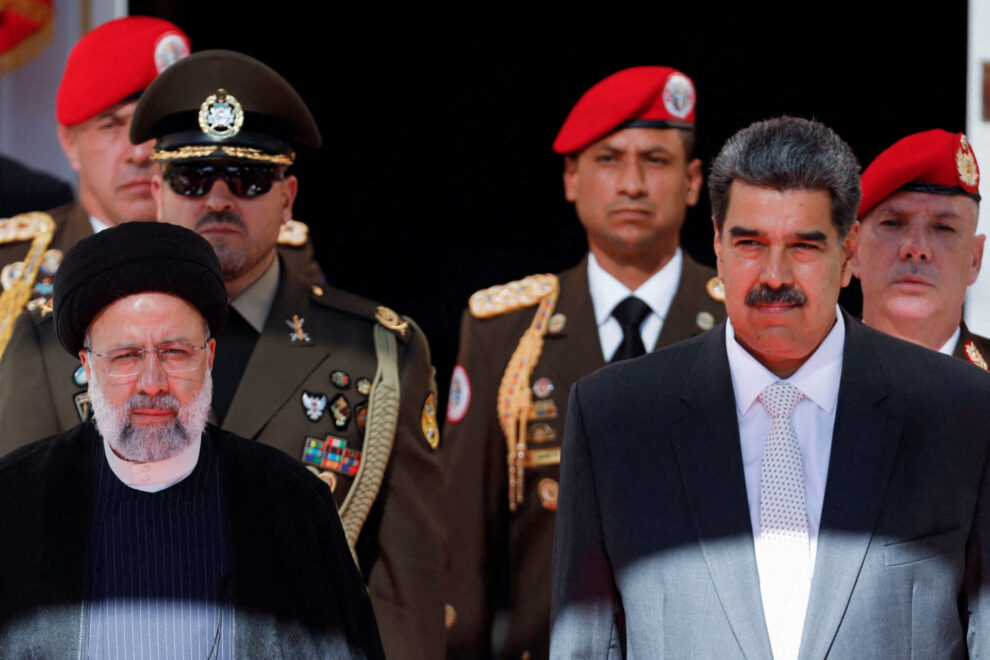Earlier this month, two American supersonic fighter jets flew over Georgetown, the capital city of Guyana. The US show of force is not only for the attention of Venezuela’s socialist regime who has been escalating toward a military conflict with its smaller neighbor since at least September 2023 when Nicolás Maduro returned from Beijing. The message of sending two F/A-18 Super Hornets flying from a nuclear-powered aircraft carrier sailing in the Caribbean Sea is also for the Islamic Republic of Iran.
At first glance, the Venezuela-Guyana conflict is about a century-old border dispute of a dense territory called the Esequibo that makes up two-thirds of Guyana’s land mass but only 15 percent of its population. But the conflict is much more than that and has less to do with Guyana’s land border and more to do with the maritime domain.
An Iranian warship, a merchant ship converted to a military vessel for the Islamic Revolutionary Guard Corps Navy called the Shahid Mahdavi crossed the equator into the Southern Hemisphere for the first time on May 4. Its mission is secret and destination unknown. Three years ago, two other warships from Iran’s conventional navy followed a similar route when they sailed around the Cape of Good Hope and crossed into the South Atlantic with a reported destination of Venezuela. Back then, the warships changed course and proceeded around West Africa en route to St. Petersburg.
It’s unclear whether the Shahid Mahdavi will cross the Atlantic this time but what is clear is that the IRGC’s armament has already arrived in bulk quantities to Venezuela.
While the IRGCN warship sails somewhere in the Southern Hemisphere, a Venezuelan naval vessel, the Guaiquerí-class patrol vessel PC-21 was spotted on May 8 sailing toward Guyana’s territorial waters equipped with stealth technology and anti-ship missiles courtesy of China and Iran. This happened at least once before in recent weeks but this time the Venezuelan naval vessel was escorted by Iranian-made Peykaap-III small boats, the most advanced fast attack craft in the IRGCN arsenal that arrived in Venezuela last year.
For more than a decade, Iran has been equipping Venezuela with modern weaponry to include long-range drones, smart bombs, cruise missiles, rockets, and, of course, the combat boats. These weapons systems are not meant to be used in a conventional military fashion but instead used in asymmetric amphibious assaults, like the tactics used by the Houthi rebels off the coast of Yemen and in the Red Sea.
The Iran-sponsored, Houthi long-range piracy attacks against commercial vessels that froze commercial shipping through the Red Sea is a template that needs to be carefully studied by Latin American military analysts. The net effect of choking off the Egyptian economy and further isolating Israel as it fights a three-pronge war against the Houthis, Hezbollah and Hamas is a modus operandi that Iran is taking across the Atlantic into the Caribbean. This time aimed at the United States with the mounting Venezuela-Guyana conflict as the catalyst.
Most analysis of the Venezuela-Guyana conflict revolves around the Esequibo region. The dense jungle between Guyana and Venezuela was delineated by the UK in the late nineteenth century when Guyana was a colony and negotiated with Venezuela via the United States. Venezuela cried foul and argued that backdoor shenanigans were involved in the 1899 Paris Arbitral Award that established the Esequibo as part of Guyana’s sovereign territory. Decades later, Venezuela took its case to the UN who mediated the 1966 Geneva Agreement known as the “agreement to come to an agreement” tabling the border dispute for resolution in the future.
The future arrived in 2020 when the International Court of Justice accepted the Esequibo case under its jurisdiction and began the proceedings to arbitrate the border dispute. Venezuela’s Maduro regime does not recognize the ICJ’s authority and, instead, held a national referendum about the Esequibo on December 3, 2023, to prompt the passage of a new law last March in the regime-controlled National Assembly declaring the “Guayana-Esequiba” as Venezuela’s twenty-fourth state. This is the casus belli for Venezuela’s war.
The history is important, but the current framing of this dispute as one of recovering lost territory and claiming sovereign lands is what the Maduro regime’s propaganda machine wants the world to believe. Venezuela neither has the means nor motivation to recover a territory that effectively has been governed by Guyana for more than a half century. This conflict is not about the Esequibo. It’s about the Atlantic.
Even if Maduro were to “invade” the Esequibo with ground forces, the Venezuelan military would be withered away by Mother Nature while the Guyanese continues to grow its GDP at more than 30 percent per year by bringing the largest recent offshore oil discovery in the world to market. The 11 billion barrels of light crude discovered in 2015 is the source of Guyana’s recent economic boom.
But the boom could be a bust if Venezuela and Iran are able to disrupt commercial shipping in the maritime corridor that connects the Atlantic to the Caribbean Sea.
If Israel and Ukraine have taught us anything it’s that the second and third order economic effects of those wars are what is changing the geopolitical landscape of the world, especially in the maritime domain. In the case of the Ukraine war, it’s the inflation of food prices due to supply chain disruption of wheat and fertilizers produced in Russia and Ukraine that has impacted African and Latin American agro-industries and economies. In the Gaza war, it’s the shutting down of shipping lanes through the Suez Canal that has slowed humanitarian aid, further pressuring Israel and diverting maritime traffic around the Cape of Good Hope, where the IRGCN warship is currently headed.
The South Atlantic is a maritime domain that is arguably among the strongest in illicit trade and weakest in maritime security. Known for transatlantic criminal and terrorist networks, notably Hezbollah who operates from Brazil to Guinea Bissau. It’s a body of water, prime for revisionist, authoritarian powers in Iran, Russia, and China to test out their ambition for a new multi-polar maritime security belt.
Iran, Russia and China have already carried out a half-dozen joint naval exercises in the Gulf of Oman and Indian Ocean since 2018 and aspire to bring these drills to the Atlantic Ocean. Venezuela may provide them the pretext to do so.
The third smallest country in South America with the fastest growing economy in the world is about to enter the fight of its life. But Guyana is not Ukraine and does not have the military means to deter Venezuelan aggression. This war, however, is not really about Guyana.
Iran, Russia and China have ensured their proxy, Venezuela, is ready to start the first inter-state war in Latin America since 1941, when Ecuador and Peru fought a border war that lasted less than a month. But unlike that war, this is less about the local conflict and more about the international context of turning Great Power Competition into Great Power Conflict. After Ukraine, amid Gaza, it’s now Venezuela’s turn to take proxy warfare to the shores of a US-allied nation.
Source: Middle East Forum










